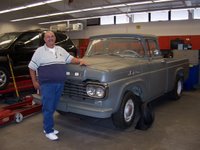The First Mayor

Thomas Murphine, Our First Mayor
In good times seems everyone’s a hero.
In bad times, the heroes rise.
Thomas Murphine, first mayor of San Clemente ruled over
our seaside city for 6 years and had his share of things that
could’ve broken a lesser man. He came in without much fanfare
and left the same way. Called to serve, he did so at the
end of a stretch of good times. San Clemente’s once bright
real estate candle all but went out.
Its 1000 residents shrunk to 250.
Murphine met city founder Ole Hansen and became good
friends while serving in Washington’s State Legislature.
Murphine was the City Harbor Commission’s legal advisor.
Ole owned a successful country store. As Seattle’s Mayor,
Ole appointed Murphine Supervisor of Public Utilities.
The friends survived the famous public workers strike,
then went to Santa Barbara in the early 1920s to work on
the Porter Hotel project. It wasn’t meant to be. The hotel
went down in flames. Had it not been for the 1925 earthquake,
which demolished the hotel, “perhaps there wouldn’t have
been a San Clemente,” says John Hall, grandson of Murphine.
They moved onto San Clemente. Murphine and partner
Trafford Huteson’s brokerage firm was granted the land
sales contract. The paper said, tongue-in-cheek, “As Murphine
and Huteson are from Seattle, they cannot work good in the rain.
They were not used to it before coming to Southern California.”
San Clemente municipalized in February 1928 with 14 city officers
including the mayor. Ole Hansen Jr. deferred the role.
Murphine accepted. Heroes do that.
He was on the architect board that made town laws including
Spanish designs and red roofs. When Murphine took office,
San Clemente claimed to be the wealthiest city per capita in America.
Five years later, not even its founder could afford to live here.
The Bad Years
A 1927 paper said building was still booming, but words couldn’t
boost the economy. The Depression hit the tender new growth of
San Clemente hard. “They all lived very well in the early years
before the crash,” says Hall. October 1929 came. Taxes or
mortgages got most homes.
All the good publicity in the world couldn’t bring in sales.
Paradise was taking its toll. Rumors always flew about what
happened with Ole and Murphine’s friendship, once strong
enough that Murphine threw his support behind what many
called Ole’s “harebrained scheme.” Close for years, they’d
gone through major setbacks and an earthquake. Eventually
their friendship cracked. Seattle had drawn them together.
San Clemente would split them apart.
The depression didn’t help. Everyone was looking for someone
to blame. At a council meeting, Murphine indicated he’d been
responsible for securing the city’s water. That did it. Rather
than “water under the bridge,” Ole thought Murphine was claiming
Ole’s gift to the city. Actually, both were correct. Homer Banks said,
“One of Mayor Murphine’s first official acts was to formerly accept
on behalf of the city, the $500,000 water system…built by Hansen
and the Cotton Syndicate …for which the city paid $1.00.”
The rift deepened. Murphine continued serving. Ole left in 1932
but had a recall election to remove Murphine. Though ineffective,
(174 favor to 130 against) it created a bitter separation
resolved only shortly before Ole’s death.
While Murphine was mayor, the pier, hospital, golf course and
many landmarks were built. Murphine was a prominent athlete
at UW Seattle. His Seattle contacts brought baseball spring
training to our new ballpark. He had a non-nonsense attitude.
News Editor, Jim Farquhar wrote about a councilman who wanted
to distribute beer. “The Mayor said that if the police commissioner
wanted to sell beer, shoe buttons or peanut brittle, it was OK
with him, so long as he didn’t do it in the street and scare the
horses.” Now that’s just good common sense. (er…horse sense.)
Then came the last straw. In 1933, after it was featured in Western
Decorator, San Clemente swallowed Murphine’s home. Built on an
old Indian graveyard, another quake, (Long Beach) left a growing
fissure in his front yard. The house started moaning as if expressing
the pain the entire city was feeling. Like a sick person, it began to
shake. Finally it exploded and fell in the earth. Only the beautiful
red roof could be seen. There are no comments I could find on what
Murphine may have said, but his dream home was gone.
Ole lost his to the bank.
With his stunning ocean-view home now rubble, Murphine moved
the family to a local apartment to continue duties as mayor and
daily business of Huteson-Murphine. He helped as Hamilton
Cotton got Bank of America to change the tile roof codes so that
more houses could be sold. Even so, banks took home after home.
It was FDR a friend of Cotton’s who bailed out San Clemente.
66 men got jobs. That was probably most of the men in town.
That WPA project is where our beautiful eucalyptus and palm
trees came from. Those trees saved us.
After Murphine moved his family back to LA on 42nd Place,
he resigned. He formed partnerships and practiced corporate
law where one of his clients was The Ringling Brothers.
John Hall was six when his father died. Murphine willingly accepted
that role too, bringing his daughter and grandson to his home.
“He was the big lord of the family,” Hall recalls fondly. Murphine
taught Hall to memorize the 33 Presidents by awarding a silver
dollar for each one learned – a hefty incentive back then.
“He was a hero to me in my formative years,” says Hall.
If it weren’t for Murphine, we wouldn’t have La Cristianita
monument. He collected Indian arrowheads and found the
area’s heritage fascinating. Murphine and Father St. John O’Sullivan
got the Board of Supervisors to officially recognize the site.
Murphine became the city’s first preservationist.
What might Murphine say today of San Clemente? Hall, the grandson
who lived with Murphine during his last ten years says, “He’d be pleased.
He’d want to see it developed the right way for the greatest
good and greatest culture.”
While Ole got most of the attention, Murphine served as a good,
solid citizen, supporting the dream of a friend. Work behind the
scenes is vital to growth. Those unseen roots spur the blooms
the world sees. Thomas Murphine quietly built the roots.
Live like a hero!
Terri Marie
Terri Marie is the author of “Be the Hero of Your Own Game.”
For past articles visit heroesamongus.blogspot.com.
For a free “year of cheer” send an email to yearofcheer@aweber.com
Special thanks to John Hall, and to Lois Divel, and Pat Bouman
of the San Clemente Historical Society for their kind help &
information. Thanks also to Doris Walker’s book.
Life Lessons from Thomas Murphine
• Never Complain
In what seemed like an endless boom for the city with an ever-brighter
future, leading the almost desperate San Clemente certainly was no picnic.
Murphine didn’t complain. He served.
• Don’t Overlook the Little Things
A new city needs some organization. Can you imagine San Clemente
without house numbers to find one’s way around? The issue had to
be “addressed.” The new Mayor urged “all to cooperate with city
council in attending to this duty of citizenship.” Thank goodness.
• Don’t Live in the Past
“They were broken-hearted when their dream home on the bluff
was lost but he never talked about past disappointments,” said Hall.
Murphine picked up and moved on.
• Do Your Duty to Family and City When Called
Hall isn’t sure what would’ve happened if Murphine hadn’t taken them in.
“He came to our rescue,” says Hall. “He was a great father to me.”
• Stick by Your Values
“He was just and fair and totally honest had a good legal mind,” said Hall. “
All the people from those early days of San Clemente stayed in touch with him.”
That says a lot.
• When the World is Falling Down Around You, Don’t Get Petty
Murphine didn’t buy into the finger pointing. His comments about
not scaring the horses pretty much summed up the way he handled things.
• Don’t be Afraid to Revise in a Crisis
Although Murphine helped create the law to require red tile roofs in
San Clemente, when the depression hit and no houses were selling,
they tried something else.
Even a football player has to go another direction sometimes.
• Use a Game to Teach Skills
With astute insight Murphine used sports to teach math.
This put his grandson 2 years ahead of the class because his math
skills were so good. “He taught me how to read a baseball box score,”
says Hall. “I think if he hadn’t become a lawyer, he might’ve become
a teacher like his father. There was a lot of teaching in his soul.”






